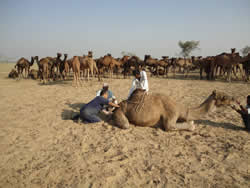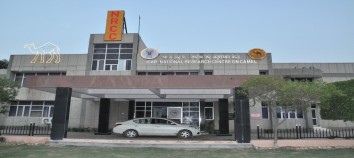CAMEL MANAGEMENT AND EXTENSION
![]() Research Programme
Research Programme
- Development of appropriate camel management practices both for prevailing and impending climate change scenario
» Research Activities
- Camel husbandry scenario building as influenced by socio- economic transformation
- Studies on precision camel farming and its contribution to house hold food and economic security
- Validation, refinement and propagation of evolved technologies for the upliftment of camel keepers
- Production of fodder crops Crassulacean acid metabolism (CAM) varieties
![]() Research Achievements
Research Achievements
- Comparative study of camel carting vs. bullock carting under hot arid region indicated that camel carting is more profitable for the small and marginal farmers due to higher cost benefit ratio and short pay back period.
- The income from camel carting was estimated to be higher in city areas as compared to rural areas because camel keepers of city area were getting more opportunities to transport different agricultural commodities as well as construction material than village area.
- Early rut in adult mature breedable male camel can be aroused by giving a regular exposure for 20 to 30 minutes in front of adult female camel at least for two to three weeks during onset of winter.
- The farm experimentation indicates that for camel thatched roofed open type kuchcha shelter and loose housing are better than asbestos roofed close type concrete shelter.
- Temperature humidity index is the lowest under thatched roofed open type kuchcha shelter followed by loose housing and asbestos roofed close type concrete shelter.
- The farming use of camel system is profitable and beneficial over the bullock system for small and medium categories of farmer in hot arid region.
- A total of 156 management practices have identified with their respective scientific relevance value in hot arid region.
- In irrigated belt foremost disease problem is mange whereas in non-irrigated zone digestive problem is major occurrence.
- The potentiality of economic utilization of camel hair has been explored by making different products (daries, blankets, shawls, bhaklas, cap, jackets etc.) and blends by using pure camel hair and mixing with other natural and synthetic fibers.
- Package of practices for camel calf rearing are developed.
- On farm testing of camel management practices of four different types are done for economic camel rearing.
- Ethograms are developed for scientific camel management.
- Established temperature humidty index for different periods at chaning calimatic scenario.
![]() Extension Activities
Extension Activities
Organised milk competition at Hadla village on dated 24.05.2011 and at Morkhana village on dated 16.7.2011. About 40 number of farmers participated and three best milk camel owners were given awards at each place. This will help encourage the farmers to rear camels for milk purpose.
As a part of fortnight celebration of Establishment Day of the Centre from 05.07.2011 to 19.07.2011 with holding of following events:
- Kisan Goshthi was organized16.7.11 at Morkhana in a desert village where camel rearers of 3 villages from Morkhana, Sindhu and Kalyansar participated.On the same day in a Camel health camp organized at same venue about 82 camels were examined and provided treatment support. Similarly Camel Milking competition was also held.
Camel Fare was organized on 17.7.2011 where all the people along with students of various schools from Bikaner and surroundings were invited to witness the activities of NRCC like Visit of NRCC campus like Camel Museum, Camel Corrals, Research Laboratories, Camel Dairy and activities of NRCC were shown through Centre’s documentary etc. About 1100 people from Bikaner and around visited the campus.
Women training was organised on dated 06.08.2011 and 46 rural ladies from Deshnok and surrounding villages participated in the training and learnt about the value added product making from Camel milk . The women showed great interest in the NRCC activities and were apprised of scientific camel management practices. Hon’ble Member of Governing Body, ICAR, Dr. Chanda Nimbakar and Hon’ble Dy. Director General (Animal Science), Dr. K.M.L. Pathak garced the valedictory function of said course. On completion of training certificates were distributed to the women participants from Dr. Chanda Nimbakar.
Diagnostic and treatment extension activities:
- To cater the need of the camel owner in the villages surrounding Bikaner, Camel Ambulatory clinics- facility has been started. This helps in management, nutrition and health related issues of the camels. Since Dec., 2010 ambulatory clinics is making at least one visit a week. Till date it has covered Jaimalsar, Gigasar, Morkhana, Husansar, Meghasar, Palana, Kesar-Desar Boran and Gadwala villages. All the sick animals reported during visit are also being treated by the subject matter specialists. Till date 483 animals have been treated with various ailments. Besides this online treatment services (phone, email) are also being provided.
- Diagnostic facility is helping state AHD especially during outbreaks of various infectious diseases (Viral, Bacterial, Fungal and Parasitic).
- Organizing camel health camps in densely camel populated areas is constantly being under taken since 2007. Till date a total of 29 health camps have been organized in Bikaner, Hanumangarh, Nagaur, Barmer, Jodhpur, Udaipur, Jaisalmer, Jhunjhnu and Pali districts.

- Free breeding input is being provided to she camels belonging to camel keepers of nearby villagers through genetically improved sires.
- Genetically improved studs are distributed free of cost to Panchayat Samities / herd owners through State Animal Husbandry Department.
- Animal Health Camps, Kisan Gosthies at the Centre as well as at adopted and other villages are organized every year.
- Centre participates regularly in the local Camel Festival and other National and State level Livestock Fairs and exhibitions.
- A museum on camel has been developed.
- Out campus exhibitions are carried out for transferreing the technologies
- Training/FLD/Educational information are provided to farmers, students and others.
- Generated a sizeable amount of revenues through various extension activities.

